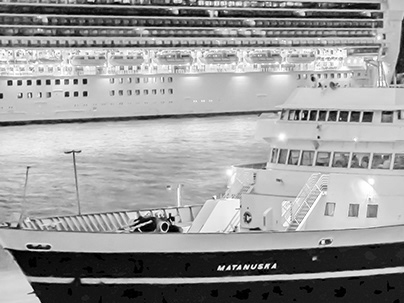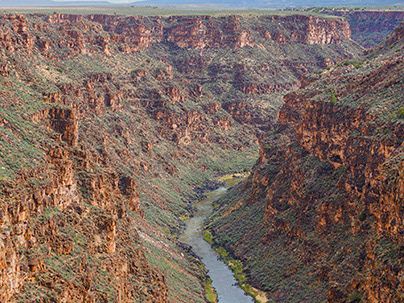Part of San Francisco Skyline
San Franscisco viewed through the cable rigging for the Golden Gate Bridge - Enough twisted wire to go around the globe 3 times.
The current evident here is why Alacatraz was such a difficult place from which to escape.
Heading Home
Everything you didn't know you wanted to know about the Golden Gate Bridge and one myth debunked.
The myth: That they paint the bridge from one end to the other, then start over, constantly. Not ture. It was only re-painted once, from one end to the other, in 1927. Ever since then, they spot paint it on a schedule and on an as-needed basis.
Length, Width, Height, Weight
Total length of Bridge including approaches from abutment to abutment is 1.7 miles (8,981 ft or 2,737 m).
Total length of Bridge including approaches from abutment to abutment, plus the distance to the Toll Plaza, is 9,150 ft (2,788 m).
Length of suspension span including main span and side spans is 1.2 miles (6,450 ft or 1,966 m).
Length of main span portion of suspended structure (distance between towers) is 4,200 ft (1,280 m).
Length of one side span is 1,125 ft (343 m).
Width of Bridge is 90 ft (27 m).
Width of roadway between curbs is 62 ft (19 m).
Width of sidewalk is 10 ft (3 m).
Clearance above mean higher high water is 220 ft (67 m).
Total weight of each anchorage is 60,000 tons (54,400,000 kg).
Original combined weight of Bridge, anchorages, and approaches is 894,500 tons (811,500,000 kg).
Total weight of Bridge, anchorages, and approaches (1937) is 894,500 tons (811,500,000 kg).
Total weight of Bridge, anchorages, and approaches (1986)* is 887,000 tons (804,700,00 kg*).
Weight of Bridge, excluding anchorages and approaches, and including the suspended structure, main towers, piers and fenders, bottom lateral system and orthotropic redecking (1986) is 419,800 tons (380,800,000 kg*).
* The total bridge weight listed for 1986 includes the reduction in weight due to the redecking in 1986. The weight of the original reinforced concrete deck and its supporting stringers was 166,397 tons (150,952,000 kg). The weight of the new orthotropic steel plate deck, its two inches of epoxy asphalt surfacing, and its supporting pedestals is now 154,093 tons (139,790,700 kg). This is a total reduction in weight of the deck of 12,300 tons (11,158,400 kg), or 1.37 tons (1133 kg) per lineal foot of deck.
Bridge Deflection, Load Capacity
Watch this video to see how the Golden Gate Bridge can move up and down by as much as 16 feet!
At midspan, the maximum downward deflection (or the distance the Bridge was built to move downward) is 10.8 ft (3.3. m). The maximum upward deflection is 5.8 ft (1.8 m).
The maximum transverse deflection, at center span is 27.7 ft (8.4 m).
Live load capacity per lineal foot is 4,000 lbs (1,814.4 kg).
As an example of how the Bridge is built to move, during the winter storms in 1982, the main span bowed approximately 6 to 7 feet
The three maximum deflections noted above at the center of the suspension bridge are due to the following loading conditions:
The transverse deflection is due to a sustained transverse wind load. The maximum transverse movement of 27.7 ft is based on the maximum allowable longitudinal movement of the wind locks at the support towers;
The maximum downward deflection is due to a condition with maximum live load on the center span, no live load on the side spans and maximum design temperature to elongate the main cables; and
The maximum upward deflection is due to a condition opposite to condition 2 above, with maximum live load on side spans, no live load on center span and minimum design temperature to shorten the cable length.
The maximum downward deflection is due to a condition with maximum live load on the center span, no live load on the side spans and maximum design temperature to elongate the main cables; and
The maximum upward deflection is due to a condition opposite to condition 2 above, with maximum live load on side spans, no live load on center span and minimum design temperature to shorten the cable length.
Main Tower Stats
The Golden Gate Bridge has two main towers that support the two main cables.
The height of a tower above water is 746 ft (227 m).
The height of a tower above roadway is 500 ft (152 m).
Tower base dimension (each leg) is 33 ft x 54 ft (10 m x 16 m).
The load on each tower from main cables is 61,500 tons (56,000,000 kg).
The weight of both main towers is 44,000 tons (40,200,000 kg).
Transverse deflection of towers is 12.5 in (0.32 m).
Longitudinal deflection of towers (shoreward) is 22 in (0.56 m) and (channelward) is 18 in (0.46 m).
The south tower foundation depth below mean low water is 110 ft (34 m).
To build south tower pier to support the south tower, construction workers pumped 9.41 million gallons (35.6 million liters) of water out of the fender that was constructed first.
Main Cable Stats
The Golden Gate Bridge has two main cables which pass over the tops of the two 746-ft-tall towers and are secured at either end in giant anchorages. The galvanized carbon steel wire comprising each main cable was laid by spinning the wire, using a loom-type shuttle that moved back and forth as it laid the wire in place to form the cables. The spinning of the main cable wires was completed in 6 months and 9 days.
The main cables rest on top of the 746-foot main towers in huge steel castings called saddles.
Diameter of one main cable including the exterior wrapping is 36 3/8 in (0.92 m).
Length of one main cable is 7,650 ft (2,332 m).
Total length of galvanized steel wire used in both main cables is 80,000 mi (129,000 km).
Number of galvanized steel wires in one main cable that are 0.192 inches in diameter is 27,572.
Number of bundles or strands of galvanized steel wire in one main cable is 61.
Average number of galvanized steel wires in each of the 61 bundles is 452.
Weight of both main cables, suspender cables, and accessories is 24,500 tons (22,200,000 kg).
The galvanized steel wire used for the main cables is carbon steel with the following average chemical composition and physical properties:
Main Cable bands are located every 50 feet along the main cables and the vertical suspender ropes are hung from the cable bands. Following the addition of the lower lateral bracing system in 1953 and 1954, it was found that the normal working of the Bridge, along with the addition of the lower lateral bracing system, had caused the main cable band bolts to lose as much as 50 percent of their specified tension. In 1954, the main cable bolts were re-tensioned by J. H. Pomeroy & Co., Inc and constituted the first application of calibrated impact wrenches for the tightening of cable band bolts.
Again in 1970s, during the replacement of vertical suspender ropes, the cable band bolts were again re-tensioned to 90,000 pounds using a Biach hydraulic bolt tensioner. This work was performed from ironworker floats hung below the cable.
Occasional retightening of main cable band bolts is undertaken when necessary based on inspections. The bolts, subject to constant temperature and load changes in the main cable produce minute changes in the cable diameter, and those changes in cable diameter, together with temperature effects on the cable band itself, cause tension in the bolts to relax. The most recent check was performed in 1999 by Steinman Boynton Gronquist & Birdsall, New York, NY. The tension was tested on a random and statistically valid sampling of cable band bolts, and it was determined that a retightening of all cable band bolts was not required at that time.
The re-tensioning of the bolts of the main cable tie-downs (which not the same as the main cable band bolts) were not a part of the Suspender Rope Replacement Project, but it is noteworthy to mention that they were re-tensioned in 2000 and 2001 for the first time since the Bridge was completed in 1937. The cable tie-down castings, located in the massive concrete pylons at the ends of the suspension span, hold the main cables in a fixed position to prevent vertical motion where the suspended span meets the approach viaducts. Proper functioning of the tie-downs depends on the clamping force of the cable bands, which in turn is dependent on adequate cable band bolt tension. In all, 256 bolts, each with a diameter of 21/8 inches x 3 feet long, were hydraulically re-tensioned to their original specification of 92,000 pounds. Bolts that had corroded over time were replaced. This project was completed by District crews.
Suspender Rope (vertical ones) Stats
The Golden Gate Bridge has 250 pairs of vertical suspender ropes that are spaced 50 feet apart across both sides of the Bridge. Each suspender rope is 2-11/16 inches in diameter. All of the ropes were replaced between 1972 and 1976, with the last rope replacement completed on May 4, 1976.
Concrete Quantities
These are the quantities when the bridge was built (1933-1937). After the original concrete roadway deck was replaced, the amount of concrete is now LESS than when the Bridge was built by 25,000 cubic yards.










